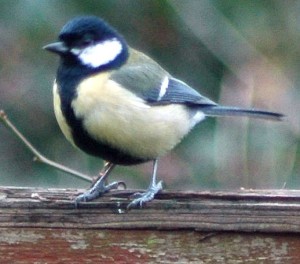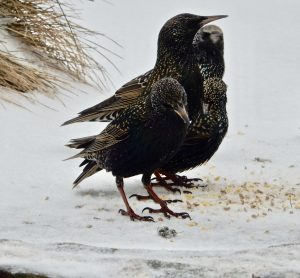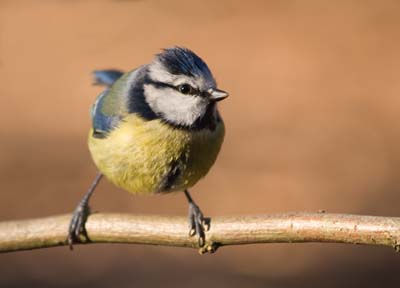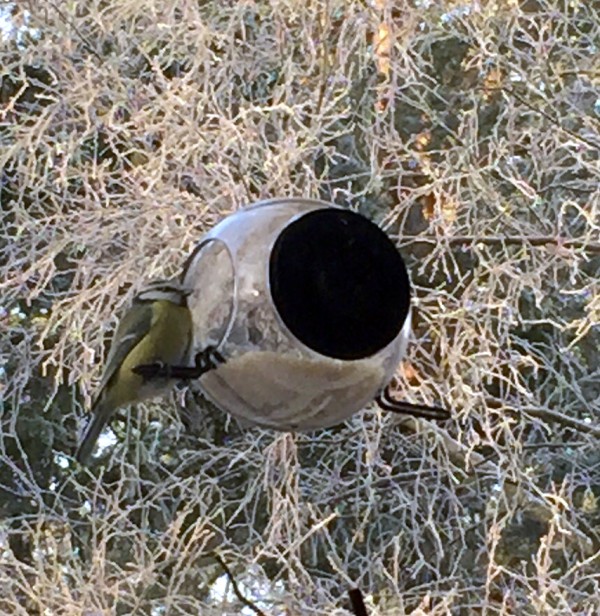Feed The Birds?

Whilst it always good to see wildlife in a natural setting, such as a woodland, it is also good to encourage wildlife in our gardens.
The woodland blog last year listed some of the strategies that might encourage insects and invertebrates in our gardens. It is also possible to encourage birds into our gardens, just as Catherine wrote about managing woodlands for birds. Many ‘everyday’ urban species of bird populations have declined in recent times: house sparrows by approximately 60% and starlings perhaps by 75%. Whilst it seems that eggs are laid and chicks hatch, many are not making it to the fledgling stage which suggests that food may be a problem. Some species like great tits and blue tits are doing well, which may be a reflection of the number of nesting boxes put up for them. As Angus indicated in his recent blog on bird boxes, birds are very sensitive to the size of the hole in the box – this influences which birds might use the box. (Further detailed instructions and information are available on the RSPB site).
Other ‘strategies’ that can encourage birds in the garden are climbers / creepers on the garden wall or shed (like ivy or honeysuckle). These offer not only nesting opportunities, but also are home to insects, spiders and other invertebrates – much needed sources of protein for birds. Areas of long grass, compost heaps and even bare soil offer further opportunities for foraging and worm collecting. Trees and bushes that offer berries and fruits in late summer and autumn represent other sources of food.
 One can go a step further and put out food offerings for birds, but it is wise to heed the advice of the RSPB. Putting out bread and bread crumbs probably does not serve birds well. Treats could include grated cheese, breakfast cereals, crumbled biscuits and cake. The RSPB also suggests porridge oats, rice, pastry and even overripe strawberries can be put out. Such foods offer a richer variety of nutrients. The RSPB website offers detailed and comprehensive advice of what and when to offer food to garden birds. Winter feeding benefits many birds as this is often a time of food shortage – few insects or worms, limited fruits, berries and seeds. This is particularly true in severe weather (snow, very low temperatures) when twice daily feeding might be appropriate. High fat foods will offer birds the energy to cope with the cold weather.
One can go a step further and put out food offerings for birds, but it is wise to heed the advice of the RSPB. Putting out bread and bread crumbs probably does not serve birds well. Treats could include grated cheese, breakfast cereals, crumbled biscuits and cake. The RSPB also suggests porridge oats, rice, pastry and even overripe strawberries can be put out. Such foods offer a richer variety of nutrients. The RSPB website offers detailed and comprehensive advice of what and when to offer food to garden birds. Winter feeding benefits many birds as this is often a time of food shortage – few insects or worms, limited fruits, berries and seeds. This is particularly true in severe weather (snow, very low temperatures) when twice daily feeding might be appropriate. High fat foods will offer birds the energy to cope with the cold weather.
For spring and summer, the RSPB site offers further sound advice. Only certain foods should be offered, as it is possible to do more harm than good. High protein foods might be appropriate when the birds are moulting – the protein is used for the growth of new feathers. The site offers lists of suggested foods, and some to avoid at this time of year (such as fat, peanuts and bread). This page list the pros and cons of bird seed mixtures
- Sunflower seeds
- Nyjer seeds
- Peanuts
- Bird cakes and food bars
- Live foods (e.g. mealworms)
- Dog and cat food
- Milk and coconut
- Rice and cereals.

There is also guidance on offering household scraps. There are also suggestions on the hygiene of feeding sites, tables and the opportunity to buy items from their on line shop.
Birds also need water to help in bathing / preening their feathers, and whilst insectivorous birds get much of their water from their diet, seed-eating birds whose diet is relatively dry, need more water for drinking.
Support the RSPB’s “Feed the Birds” weekend on 25th and 26th October.
Thanks to Art Symons for image of Starlings.
Comments are closed for this post.


The results of the January 2008 Birdwatch (garden) survey are available here
http://rspb.org.uk/birdwatch/results/
In first place were sparrows, then starlings, followed by blackbirds – though the average number of birds seen in each garden was down compared to 2004, the number of finches was up.
Chris
30 October, 2008